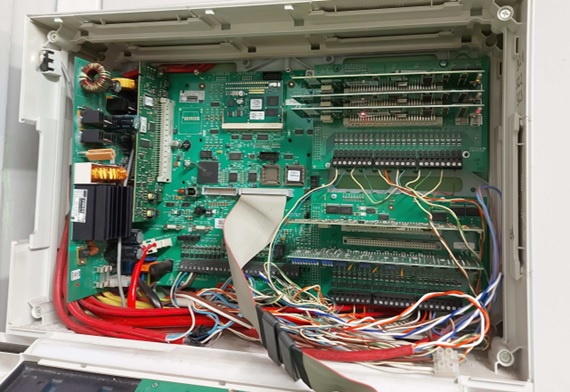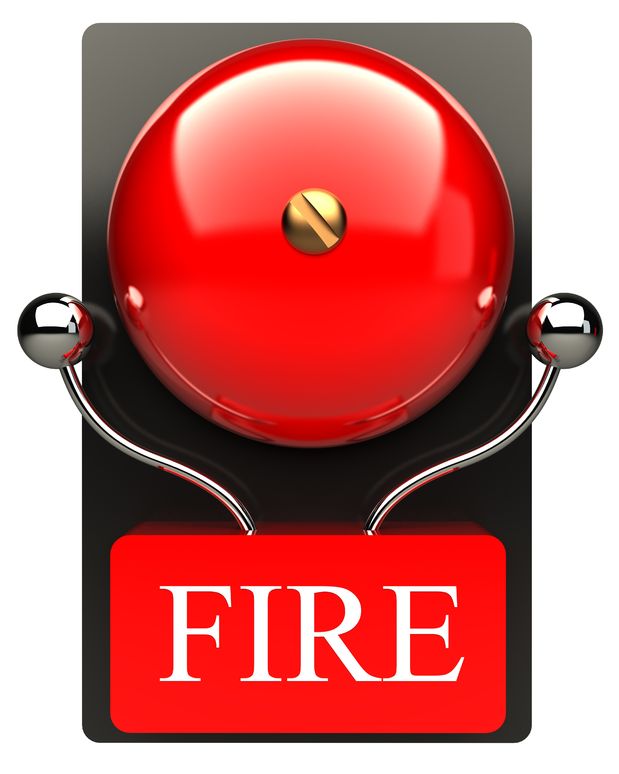Fire Alarm System
- Can I use the Fire Alarm System (FAS) to control fire protection devices?
- Monitoring of the State Fire Service when is it required?
- Supervision of staircases – how many detectors?
- Fire Alarm System basic design – what scope should it be and why should it be done?
- Who can do Fire Alarm System design?
- Principles of arrangement of acoustic alarm devices in Fire Alarm Systems
- Why are the detector zones being separated?
- Advantages of using distributed Fire Alarm Systems.
Can I use the Fire Alarm System (FAS) to control fire protection devices?

The answer to this question is ambiguous and depends on the size and complexity of the object. This should be avoided, the FAS should provide information about the activation of a given fire system, eg smoke extraction, closing fire doors etc. but without controlling individual devices. Applications for non-complex buildings are allowed, where the FAS controls fire dampers and monitors their condition, if the FAS manufacturer provides a tested solution that enables this type of operation and does not burden the system. However, it is not recommended for more complex sites..
The primary and overarching tasks posed Fire Alarm System are:
- as soon as possible detection of a fire, informing the staff about the threat and giving signals initiating the actions provided for in the fire scenario,
- starting an alarm in order to evacuate building users who may be at risk of fire.
We avoid solutions that additionally burden the Fire Alarm Center and may affect the above-mentioned actions.
The control panels for fire protection devices, in addition to controlling functions, must perform power supply functions, in particular in cases where high-power loads such as 230 VAC / 400 VAC electric motor and drives are handled. In such cases, it is necessary to control the power supply line and cabling continuity, which is not possible with the use of Fire Alarm Control Panel.
In the case of several / a dozen simultaneous loads, motor high-current loads require a cascade start-up in order to limit the starting currents, which may not be possible without the use of dedicated fire control panels designed for a given task.
Currently, there are several manufacturers of control panels for fire devices on the market who provide devices made for a given project, they have approval certificates.
To sum up, in complex facilities the control functions of the Fire Alarm System should be limited only to initiating the operation of individual fire devices equipped with dedicated control panels.
Monitoring of the State Fire Service when is it required?

Decree of the Minister of Internal Affairs and Administration of 7 June 2010 on fire protection of buildings, other building objects and areas (Dz. U.10.109.719) point § 28.1 mentions not only the obligation to use the Fire Alarm System, but also the obligation to connect the signaling and alarm devices of the Fire Alarm System with the State Fire Service. This applies to all facilities listed in the regulation.
Supervision of staircases – how many detectors?
I have recently been asked whether a staircase with a height of 18 m can be monitored by one point smoke detector installed under the ceiling, the operation of which will open the smoke flap and the air intake for the needs of smoke extraction.
From the point of view of the safety of evacuating people and fire safety rules, the answer is NO.
Nevertheless, it is literally possible.
The above discrepancy is the result of the rule – what is not prohibited is allowed. In this case, it is the result of the lack of guidelines for the supervision of staircases in the two most popular technical standards in Poland for the design of fire alarm systems, i.e. the guidelines of the Association of Fire Engineers and Technicians and the PN-CEN / TS 54-14 standard. In contrast, the NFPA 72 guidelines, and especially VdS 2095, define the rules of staircase surveillance quite clearly and in this matter they should constitute the design basis.
Why is it so important and why should projects with one point indoor smoke detector in staircases higher than 10-12 m be rejected?
Treating the topic literally, it can be assumed that the smoke rising up will eventually reach the ceiling / roof and the detector will work, but this is a very lame truth, because:
- in staircases, during their normal use, the air flow is at a minimum level, so the smoke will rather not rise up, but will fill the staircase’s volume until it finally reaches the ceiling,
- in the event of a fire and a source of smoke on the lower level / storey, until the smoke exhaust system is activated, evacuation from higher levels / storeys will be difficult or impossible,
- RPO buttons (manual smoke exhaust buttons) are usually installed on the lowest and highest level / storey of the staircase, which, for example, in the discussed staircase with a height of 18 m will result in the fact that someone coming from only these storeys will be able to start the smoke exhaust manually, which can also be reduced only to the ground floor level (until smoke appears on the top floor) and only when someone does not forget to press this button, which in the statistics looks terrible.
To sum up, surveillance of staircases higher than 10-12 m should be performed by point smoke detectors installed:
- under the ceiling / roof,
at intermediate levels / storeys (at least every second, in staircases with a minimum clearance between the flights of stairs at each level).
Fire Alarm System basic design – what scope should it be and why should it be done?
During the investment process requires a number of arrangements with the investor, appraiser for. Fire systems designers and cooperating with the installation of Fire Alarm System is almost unnecessary to prepare the project documentation of the previous executive. The construction law is limited only to the construction design, which does not mean that other studies can be carried out. Such documentation may be a basic design showing:
- system structure,
- scope of the system,
- devices used,
- the detection methods used
- points of contact with other systems,
- locations of the most important elements of the system,
which have obtained the required opinions and arrangements.
Due to the simplified nature of such documentation, changes can be made easily and quickly, thanks to which we will avoid time-consuming work of the designer and shorten the process of reconciliation and design.
However, it should be remembered that the basic design is insufficient to complete the designed installation.
Such a document is the basis for the implementation of the detailed design and very often the basis for the preparation of a price offer for the installation.
Who can do Fire Alarm System design?
Standards, design guidelines and the law that do not define the requirements for the designer of the Fire Alarm System. However, according to CEN / TS 54-14: 2004 clause 6.15::
„6.15 Kwalifikacje
Osoba fizyczna lub prawna wykonująca projekt i przygotowująca dokumentację wg 6.13 powinna mieć odpowiednią wiedzę teoretyczną i praktyczna, niezbędną do wykonania zadania.”
and similarly in the new edition of the standard in English CEN / TS 54-14: 2018 (E)
„6.16 Qualifications
The person or organization carrying out the design and preparing the documentation of 6.14 shall have adequate theoretical and practical knoledge to able to carry out the necessary work.
NOTE In some European countries there may be mandatory certification requirements for the design of systems.”
except for the adequate theoretical and practical knowledge, additional qualifications according to Polish Law are not required.
It is recommended that the designer undergoes design training for the manufacturer whose solutions are used in the design, as well as design training offered by certification, research and scientific units.
Ultimately, the project should receive a positive opinion from a fire protection expert according to Polish Law.
Principles of arrangement of acoustic alarm devices in Fire Alarm Systems
A key role in the evacuation of a building in the event of a fire is effective warning of the threat. The most common solution is an acoustic signal. Below I have collected the most important issues that should be taken into account when designing acoustic alarm devices, which are facilitated by the preparation of documentation and installation.
According to PKN-CEN / TS 54-14
Acoustic alarm devices should be located in such a way that:
- the alarm level should be at least 65 dBA or it should exceed 5 dBA – ambient noise lasting more than 30 s, whichever is greater. If the alarm is to wake sleepers, the sound level at head height in bed should exceed 75 dBA,
- minimum sound levels should be achieved wherever an audible alarm sound is required,
- in any place where people may stay, the sound level should not exceed 120 dBA, if sound intensity measurement is required, use a device with a time constant, compliant with PN-EN 60651U: 2002 type 2 with weight A.
- sounds with a frequency in the range of 500 – 2000 Hz are clearly audible to most people,
- there should be at least two alarm devices in the building, even if the recommended sound level can be achieved by one device,
- at least one alarm device should be provided in each fire zone.
In order to avoid particularly loud sound levels in certain zones, a larger number of quieter alarm devices can be used instead of a few very loud alarm devices. It is impossible that the sound level is sufficient when the nearest alarm device is separated from this space by more than one door.
The level of acoustic pressure emitted by the acoustic alarm devices is given for a distance of 1 m from its source. Each doubling of the distance between the sound source reduces the SPL by 6 dB (measurement in an open space). A 6 dB reduction corresponds to a 50% reduction in SPL.
| Distance from the signaling device [m] | 1 | 2 | 4 | 8 | 16 | 32 | 64 |
| Sound pressure [dB] | 100 | 94 | 88 | 82 | 76 | 70 | 64 |
Table of decibel decrease in sound intensity for the 100dB Sounder
Where acoustic signaling is insufficient, i.e. in production halls and industry where a lot of noise is generated or employees use hearing protection, additional optical alarm device should be provided, which is treated as a supplement to acoustic signaling.
Why are the detector zones being separated?
The division detector zones is one of the parts of the Fire Alarm System design. Only detectors of one detection zone can be assigned to one detector zone.
Automatic fire detectors and manual call points should be assigned to separate detection groups. They may not include more than:
- 10 manual call points or
- 32 point automatic fire detectors or
- 32 points of multi-point heat detectors or
- one line smoke detector or
- 32 detection segments of a linear heat detector or
- individually identifiable aspirating smoke detector suction pipes.
Automatic fire detectors must constitute one detector zones at a time in the areas of raised floors, suspended ceilings or cable ducts. Otherwise, it should be possible to identify in a simple manner (e.g. on the basis of external actuation indicators) in which part of the area the detectors were activated.
Protection zones or individual detectors are programmatically combined into detector zones to which outputs of monitoring and control modules can be assigned, enabling the activation of appropriate fire protection devices. This division allows to identify the fire as to the space in which the hazard occurred.
Advantages of using distributed Fire Alarm Systems.
At one of the large facilities, I had contact with the Fire Alarm System in a centralized structure.As it turned out, such a solution has even more disadvantages than it may seem and it is not about system stability or communication errors.
Commissioning and partial acceptance turned out to be a big problem, as the system turns out to be operational only after all construction works are completed in each monitored space.
Because the investment process was divided into stages in such a way that the cable routes to the buildings in which they were handed over for collection were not ready.
The number of cables resulting from the cable routing in the cable ducts, difficulties in routing them, the use of overvoltage protections for detection loops running outside the buildings would certainly compensate the costs of using a larger number of smaller Fire Alarm Panels operating in a distributed control panel network.
